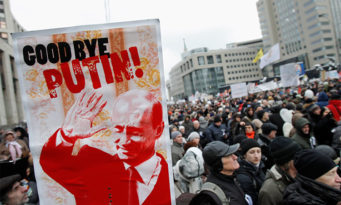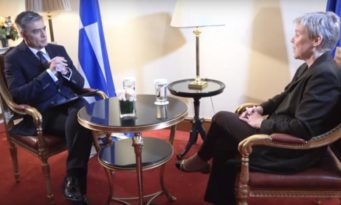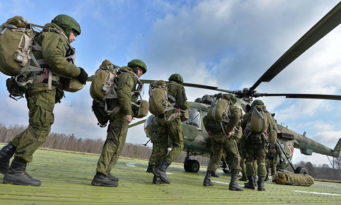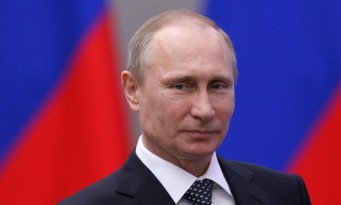General Knud Bartels: NATO ready to defend all Allies against any threat
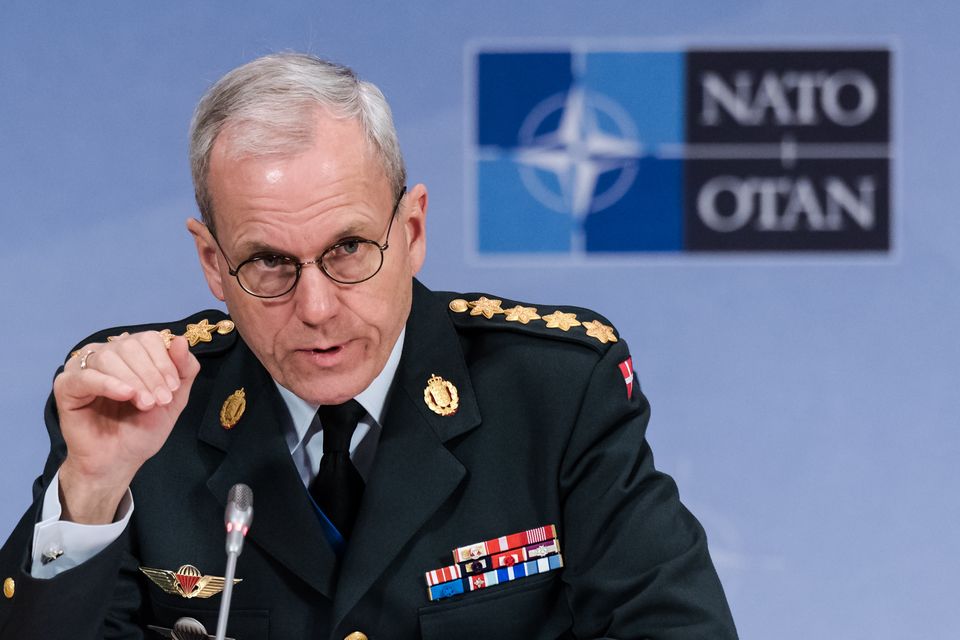
- By defencematters
General Knud Bartels, Chairman of the NATO Military Committee talks about NATOs new defence measures and Ukraine
By Eleni Panayiotou
After the annexation of Crimea and in view of the ongoing conflict in Ukraine, the European security environment has changed and NATO is trying to adapt. In a bid to protect Allies NATO has boosted co-operation with Ukraine and is taking new strategic measures. These measures include a new high readiness task force known as the “Spearhead Force”. Is the “Spearhead Force” really something new and can the cost be justified? What role does NATO really have in Ukraine and can this hold Russia back?
General Knud Bartels, Chairman of the NATO Military Committee talks to us about NATOs new defence measures and Ukraine
How does the Readiness Action Plan (RAP) increase Europe’s security? What are the key changes implemented and the differences between the Very High Readiness Joint Task Force (VJTF) and the NATO Response Force (NRF)? Why the need for the VJTF when in fact we had the NRF?
First of all let me say that NATO has always adapted to changes in the security situation. That was the case during the Cold War, after the Cold War, engaging in the largest mission and coalition in modern history in Afghanistan and returning from Afghanistan. Now a changed situation in Europe has emerged and NATO will adapt again.
The RAP increases Euro-Atlantic Security through several measures. It responds to the challenges posed to the East of the Alliance as well as to those emanating from the South. With its two main pillars, Assurance measures and Adaptations measures, NATO has ensured that it is ready to respond swiftly and firmly to new security challenges.
There are a number of key changes that have been implemented and so I will highlight but a few. The Assurances measures which started in May 2014 include the continuous air, land and maritime presence and military activity in the eastern part of the Alliance on a rotational basis to which all 28 Allies contribute. What does this mean essentially? NATO has increased the number of aircraft on air policing patrols over the Baltics, aircraft have been deployed to Bulgaria, Poland and Romania for training and exercises, we have sent more ships to patrol the Baltic Sea, Black Sea and the Mediterranean, deployed ground troops to the eastern parts of the Alliance for training and exercise, on a rotational basis, as well as commencing AWACS surveillance flights over the territory of our eastern Allies.
With regard to Adaptation Measures we are enhancing NATO’s military posture and readiness levels. The Defence Minister’s in February this year agreed to more than double the size of the NATO Response Force, from 13,000 to 30,000 and as was announced at the Wales Summit in 2014, we are creating a new 5,000-strong quick reaction Very High Readiness Task Force (VJTF) also known as the “Spearhead Force”.
The lead elements will be able to move within 48 hrs and these troops will be supported by air, sea and special forces. This already sends a message that NATO is ready and able to meet any potential threat quickly and effectively.
Aside from doubling the size of the NRF, six Allies are acting as framework nations for the new Spearhead Force. France, Germany, Italy, Poland, Spain and the United Kingdom have offered to take up this role, in rotation, in the coming years. This will ensure that the Spearhead Force can be sustained for the long term. Some of them have already begun training and testing such an interim force.
Finally NATO Defence Ministers in February also decided on the immediate establishment of the first six multinational command and control units in Bulgaria, Estonia, Latvia, Lithuania, Poland and Romania. They will make rapid deployment easier, support planning and exercises, and send a clear message to any aggressor that an attack will be met by the Alliance as a whole.
As for the main difference between the NATO Response Force (NRF) and VJTF, the NRF was established in 2003 as a high readiness force comprising of land, air, sea and special forces units capable of rapid deployment. The NRF is designed to perform a wide variety of tasks including: Immediate collective defence response capability, prior to arrival of other forces; Crisis management & peace support operations; and Disaster relief and the protection of critical infrastructure. The VJTF is a new force that has been added into the overall NRF structure to reinforce the NRF and be readily deployed.
What about cost? Is the Readiness Action Plan the best and most affordable option? Does the RAP go against the idea behind Smart Defence?
The cost of the VJTF is currently being discussed. Of course, any increase in readiness has a cost. Whether the overall cost to Allies or NATO wil increase is dependant on national and NATO political decisions. Normally, it will be a combination of some common funding, meaning funded out of the NATO budget and also then funded by the participating nations.
What we need to remember is that we are facing a changed security environment which is why last September Allied leaders at the NATO Summit in Wales made a pledge to aim to spend 2% of GDP on defence within a decade, and to spend that money more efficiently. This will not happen overnight, and it’s not easy but it’s important to spend more in defence, and also to spend on the forces and capabilities we need.
I think if you look at what Smart Defence is at its core; a cooperative way of generating modern defence capabilities that the Alliance needs, in a more cost-efficient, effective and coherent manner, the RAP is in line with that idea.
To protect our societies and our way of life, we must invest more in defence. The cost of insecurity is too high a cost to pay.
If deployment of the VJTF becomes necessary who will have control and how is it expected to operate?
The VJTF is part of the overall NRF structure and the NRF structure falls under the overall command of the Supreme Allied Commander Europe. As to who agrees that it should be deployed, that decision rests with the Secretary General of NATO and the North Atlantic Council members under recommendation from the NATO Military Committee.
Rapid deployment of the VJTF to the eastern part of Europe for example, will be facilitated by small command and control and reception facilities called NATO Force Integration Units (NFIU). As an initial step, NFIUs are being established in Bulgaria, Estonia, Latvia, Lithuania, Poland, and Romania, and will be staffed on a rotational basis
NFIU’s will work in conjunction with host nations to identify logistical networks, transportation nodes and supporting infrastructure to ensure NATO high-readiness forces can deploy into an assigned region as quickly as possible. With the help of NFIUs, some units of the VJTF will be capable of moving in just two days, with most ready to move in less than seven days.
The development of the VJTF is a process that is expected to continue as the Alliance refines the concepts and capabilities over the next few years. This evolution will continue into 2016 as we move towards a more mature capability and continue to adapt to future threats.
After the Balkan operations and after a decade of Afghanistan, does Europe still face an operational gap (forces ready to be projected in area or out of area) when we refer to the potential of engaging in expeditionary missions?
NATO is used to the long haul and one of our greatest strengths is our ability to adapt. During the Cold War, the challenge was clear and largely predictable. NATO deterred attacks and kept our nations safe without firing a shot.
Then for the next 25 years, NATO went out of area. Together with our partners we went into combat beyond our borders to manage crises that could threaten us at home. NATO is once again making fundamental changes. Today, we do not have the luxury to choose between collective defence and crisis management, we have to do both at the same time.
In the face of multiple risks, NATO is adapting and staying strong as it has always done so I would say NATO is ready and able to defend against any threat but also I would refer to my answer on defence budgets, to continue to protect our societies and our way of life, we must invest more in defence.
What role does the VJTF play in deterring hybrid warfare? What can NATO do in order to deter the non-military dimensions of hybrid warfare
NATO stands ready to defend all Allies against any threat, whether conventional or hybrid. The Alliance is also developing a new hybrid strategy, to be fully in place by the Warsaw Summit in 2016. And work is underway.
This will involve improving our situational awareness and intelligence, and speeding up our decision-making. As hybrid warfare also affects the economy and cyberspace, we are strengthening our coordination with other organisations, including the European Union.
The Readiness Action Plan is also key to NATO’s response. To deter diffused, ambiguous or hybrid threats effectively, we need to act promptly, whenever and wherever necessary. That’s why we are taking steps to have the right forces at the right place at the right time.
What can NATO do to protect Ukraine from Russia’s ‘little green men’ whilst adhering to International law and how do you believe NATO will be able to protect allies from a Russian Trojan Horse?
First of all we need to establish some definitions. NATO has what we call an Article 5 commitment which means that if one member country is attacked, it is considered an attack on all member-countries and we will defend each other.
Ukraine is not part of the alliance and therefore is not covered by this commitment.
However, Ukraine is a very close partner to NATO and that is why after Russia’s action against Ukraine, we took immediate measures to strengthen our readiness and boosted our cooperation with Ukraine. We are working on ways to improve the ability of NATO troops and Ukrainian troops to operate together. Through more exercises, more cooperation, more shared training and education.
NATO is supporting Ukraine with political and practical support.
We have created five trust funds: logistics; command & control and communications; cyber defence; retraining former soldiers; and helping wounded soldiers recover. These will help make Ukraine’s defence forces more modern, more transparent, and more effective. Funding amounts to 3 million Euros.
At the Wales Summit we also agreed to that we will substantially increase scientific cooperation with Ukraine. The funds for scientific cooperation with Ukraine in 2014 have more than doubled to 2.2 million euros. Ukraine is now the number one beneficiary of NATO scientific activities.
These include projects in the fields of defence against chemical, biological, radiological, nuclear agents, security-related advanced technologies and energy security. And in addition, many NATO Allies are also providing practical support to Ukraine on a bilateral basis.
NATO will protect and defend every Ally against any threat. We see no imminent threat to the Alliance but rest assured that if any nation or actor violates the sovereignty of the 28 members, they will face the might of the most powerful alliance in the world. NATO will defend all Allies against any threat.
What is NATO prepared to do against a Russian nuclear threat?
At the Wales NATO Summit, Allies reaffirmed that NATO will maintain the full range of capabilities necessary to defend our populations. Deterrence, based on an appropriate mix of nuclear, conventional and missile defence capabilities, is a core element of our overall strategy.
Of course, the circumstances in which any use of nuclear weapons might have to be contemplated are extremely remote. But as long as nuclear weapons exist, NATO will remain a nuclear alliance. Allies have been clear on that.
There is an escalation of NATO military exercises this year. What does NATO hope to achieve through this? Which exercises are important for the alliance?
As you are aware I am sure, NATO has a strategic command. Allied Command Transformation (ACT) leads many initiatives designed to transform NATO’s military structure, forces, capabilities and doctrine. Its main responsibilities include education, training and exercises, as well as conducting experiments to assess new concepts, and promoting interoperability throughout the Alliance. ACT plans and prepares exercises and training taking into account the needs of the Alliance and what capabilities need to be enhanced and tested
In essence, the aim of NATO exercises is to train our people to manage the full spectrum of NATO missions, whatever they may entail so all exercises are important as they offer an opportunity to learn and improve.
That is why throughout the year the Alliance exercises and trains to remain ready, to learn from each other and Partner Nations who can be invited to participate in NATO exercises.
This year with the development of the VJTF we will go through a series of exercises, trials and evaluations, The first of these took place in Germany, 4-5 March, involving the 1st German-Netherlands Corps and the exercises will continue for the remainder of 2015 in order to develop, refine and implement the VJTF
One of the largest exercises to take place this year is Exercise Trident Juncture 15 which will place in the autumn and will unite around 30,000 personnel in Southern Europe, in Spain, Italy and Portugal







